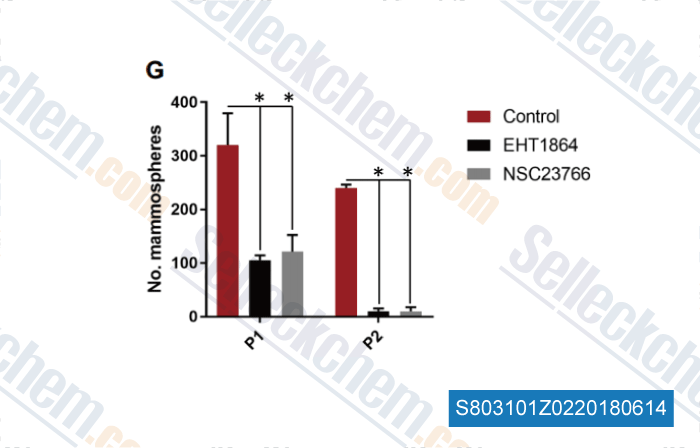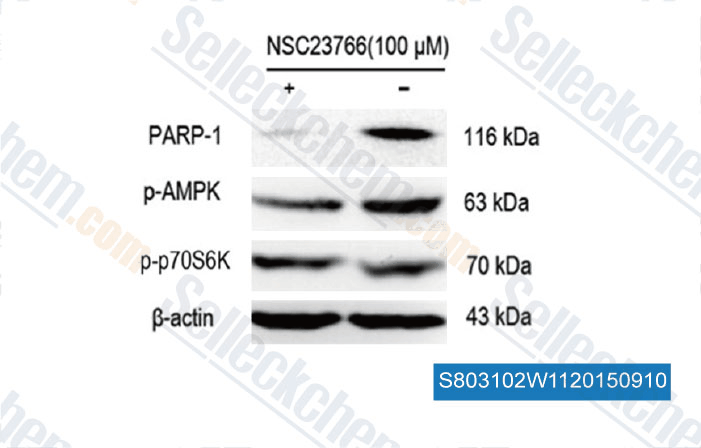|
Toll Free: (877) 796-6397 -- USA and Canada only -- |
Fax: +1-832-582-8590 Orders: +1-832-582-8158 |
Tech Support: +1-832-582-8158 Ext:3 Please provide your Order Number in the email. |
Technical Data
| Formula | C24H35N7.3ClH |
|||
| Molecular Weight | 530.97 | CAS No. | 1177865-17-6 | |
| Solubility (25°C)* | In vitro | DMSO | 100 mg/mL (188.33 mM) | |
| Water | 100 mg/mL (188.33 mM) | |||
| Ethanol | Insoluble | |||
|
* <1 mg/ml means slightly soluble or insoluble. * Please note that Selleck tests the solubility of all compounds in-house, and the actual solubility may differ slightly from published values. This is normal and is due to slight batch-to-batch variations. * Room temperature shipping (Stability testing shows this product can be shipped without any cooling measures.) |
||||
Preparing Stock Solutions
Biological Activity
| Description | NSC 23766 trihydrochloride is an inhibitor of Rac GTPase targeting Rac activation by guanine nucleotide exchange factors (GEFs) with IC50 of ~50 μM in a cell-free assay; does not inhibit the closely related targets, Cdc42 or RhoA. | ||
|---|---|---|---|
| Targets |
|
||
| In vitro | NSC23766 is identified to fit into a surface groove of Rac1 known to be critical for GEF specification. NSC23766 effectively inhibits Rac1 binding and activation by the Rac-specific GEF Trio or Tiam1 in a dose-dependent manner without interfering with the closely related Cdc42 or RhoA binding or activation by their respective GEFs or with Rac1 interaction with BcrGAP or effector PAK1. [1] NSC 23766 is active in regulating Rac GTPase functions on cytoskeleton and many cell functions including cell cycle, cell growth, adhesion, migration and gene transcription. NSC 23766 (50 μM) potently blocks serum or platelet-derived growth factor-induced Rac1 activation and lamellipodia formation without affecting the activity of endogenous Cdc42 or RhoA in NIH 3T3 cells. NSC 23766 reduces Trio or Tiam1 but not Vav, Lbc, Intersectin, or a constitutively active Rac1 mutant-stimulated NIH 3T3 cells growth and suppresses Trio, Tiam1, or Ras-induced cell transformation. NSC23766 dose-dependently inhibits PC-3 cells proliferation and anchorage-independent growth. 25 μM NSC23766 inhibits the PC-3 cell invasion through Matrigel by 85%. [1] 50 μM NSC 23766 inhibits thrombin-induced activation of Rac1 an d Rac2 in human platelets, as well as platelet aggregation. [2] NSC23766 prevents Aβ40 and Aβ42 production in swAPP-HEK293cells without affecting Notch and sAPPα. NSC23766 prevents γ-secretase activity in cell, but not act as a direct γ-secretase inhibitor. NSC23766 dose-dependently reduces levels of secreted and intracellular Aβ40 with IC50 of 48.94 μM. 50 μM NSC 23766 inhibits release of Aβ42 by 57.97%. [3] NSC23766 regulates endothelial nitric oxide synthase expression and endothelial function. 100 μM NSC23766 represses the eNOS promoter activity by 60% in bovine aortic ECs and by 30% to 35% in bEND.3 cells. Inhibition of Rac1 with NSC23766 destabilizes eNOS mRNA and shortens its half-life to 17 hours. NSC23766 dose-dependently attenuates ACh-induced relaxation of wild-type mice aortic rings. [4] NSC23766 inhibits cell growth and induces apoptosis. NSC23766 decreases MDA-MB-468 and MDA-MB-231 cells viability in a dose-dependent manner with IC50 of ~10 μM, which is not correlated with the status of estrogen receptor (ER), progesterone receptor (PR), Her2, and p53 mutation. NSC23766 has little effect on the survival of the MCF12A normal mammary epithelial cells. After 24 hours expose to NSC 23766, MDA-MB-231 cells showes an increase from 41% to 65% in G1 phase and a concomitant decrease in S and G2-M phases. 100 μM NSC23766 induces a six-fold increase of apoptotic MDA-MB-468. The inhibition of NSC23766 on cell cycle arrest or apoptosis in breast cancer cells is mediated by downregulation of cyclin D1, survivin, and X-linked inhibitor of protein apoptosis. [5] |
||
| In vivo | NSC23766 induces mobilization of hematopoietic stem cells/progenitors. Intraperitoneal administration of NSC23766 (2.5 mg/kg) into the ‘‘poorly mobilizing ’’ C57Bl/6 mouse strain leads to a two-fold increase in circulating hematopoietic stem cells/progenitors 6 hr after injection. [2] NSC23766 alleviates lipopolysaccharide-induced acute pulmonary injury in mice. Treatment with NSC23766 at 1 or 3mg/kg not only reduces the inflammatory cells infiltration and MPO activities, but also inhibits pro-inflammatory mediators, tumor necrosis factor-α and interleukin-1β, mRNA expression. NSC23766 also reduces Evans Blue and albumin accumulation in LPS-challenged lungs. [6] |
Protocol (from reference)
| Kinase Assay: |
|
|---|---|
| Cell Assay: |
|
| Animal Study: |
|
References
Customer Product Validation

-
Data from [Data independently produced by , , Science, 2018, 11(528), doi: 10.1126/scisignal.aao6897]

-
Data from [Data independently produced by , , Cell Death Dis, 2015, 6: e1751 ]

-
Data from [Data independently produced by , , J Immunol, 2017, 198(4):1696-1705]

-
Data from [Data independently produced by , , Am J Cancer Res, 2015, 5(2): 498-513]
Selleck's NSC 23766 trihydrochloride has been cited by 110 publications
| Distinct mechanisms regulate ventricular and atrial chamber wall formation [ Nat Commun, 2024, 15(1):8159] | PubMed: 39289341 |
| GEFT inhibits the GSDM-mediated proptosis signalling pathway, promoting the progression and drug resistance of rhabdomyosarcoma [ Cell Death Dis, 2024, 15(11):867] | PubMed: 39616223 |
| Regulation of AMPK activation by extracellular matrix stiffness in pancreatic cancer [ Genes Dis, 2024, 11(3):101035] | PubMed: 38292173 |
| Targeting dermatophyte Cdc42 and Rac GTPase signaling to hinder hyphal elongation and virulence [ iScience, 2024, 27(6):110139] | PubMed: 38952678 |
| DCC, a potential target for controlling fear memory extinction and hippocampal LTP in male mice receiving single prolonged stress [ Neurobiol Stress, 2024, 32:100666] | PubMed: 39224830 |
| RBM5 induces motor neuron apoptosis in hSOD1G93A-related amyotrophic lateral sclerosis by inhibiting Rac1/AKT pathways [ Brain Res Bull, 2024, S0361-9230(24)00182-5] | PubMed: 39142444 |
| DOCK1 regulates the malignant biological behavior of endometrial cancer through c-Raf/ERK pathway [ BMC Cancer, 2024, 24(1):296] | PubMed: 38438882 |
| Sema3C signaling is an alternative activator of the canonical WNT pathway in glioblastoma [ Nat Commun, 2023, 14(1):2262] | PubMed: 37080989 |
| SAMHD1-induced endosomal FAK signaling promotes human renal clear cell carcinoma metastasis by activating Rac1-mediated lamellipodia protrusion [ Exp Mol Med, 2023, 55(4):779-793] | PubMed: 37009792 |
| Knockdown of Porf-2 restores visual function after optic nerve crush injury [ Cell Death Dis, 2023, 14(8):570] | PubMed: 37640747 |
RETURN POLICY
Selleck Chemical’s Unconditional Return Policy ensures a smooth online shopping experience for our customers. If you are in any way unsatisfied with your purchase, you may return any item(s) within 7 days of receiving it. In the event of product quality issues, either protocol related or product related problems, you may return any item(s) within 365 days from the original purchase date. Please follow the instructions below when returning products.
SHIPPING AND STORAGE
Selleck products are transported at room temperature. If you receive the product at room temperature, please rest assured, the Selleck Quality Inspection Department has conducted experiments to verify that the normal temperature placement of one month will not affect the biological activity of powder products. After collecting, please store the product according to the requirements described in the datasheet. Most Selleck products are stable under the recommended conditions.
NOT FOR HUMAN, VETERINARY DIAGNOSTIC OR THERAPEUTIC USE.
